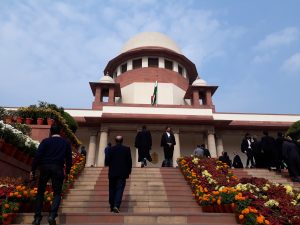The Supreme Court of India has been the subject of controversy over the remit of its powers in recent years. Over the past few decades, the scope of the judiciary has expanded to such an extent as to call into question the doctrines of separation of powers, checks and balances, and democratic legitimacy.
At the heart of the matter is the fact that the Supreme Court has accrued enormous power, beyond that which most judiciaries hold. In the 1970s, in response to the increasingly autocratic rule of Prime Minister Indira Gandhi of the Congress Party, the Supreme Court established the “basic structure doctrine” in the 1973 case Kesavananda Bharati v. State of Kerala. This doctrine, which came about through a decision by a slim margin of 7-6 judges held that Parliament could not pass amendments that altered the “basic structure” of the constitution, even though the procedure for amendments is clearly laid on in Article 368 of the Indian Constitution. The problem is that there is no consensus on what elements are part of the “basic structure” of the constitution, although fundamental rights, federalism, separation of powers, and other key elements are often listed.
The Supreme Court used the precedent set by Kesavananda Bharati in the 1980 Minerva Mills v. Union of India case to overturn parts of the Constitution (Forty-second Amendment) Act, 1976 that was passed by Parliament. Around the same time, the apex court also began to allow public interest litigation, wherein any individual could file a case based on perceived public interest regardless of standing. This stands in contrast to the United States, where an individual can file a suit only if he or she has an actual and particularized injury. As a result, the Supreme Court began to take on an increasingly powerful role, sometimes functioning as a secondary legislature.
It has also directed the government on several occasions to implement decisions that are either the prerogative of Parliament, or contradictory to the constitution. For example, in a recent decision, Anoop Baranwal v. Union of India, the Supreme Court ruled that appointments to the Election Commission of India are to be made by a three-member committee comprising the prime minister, the leader of the opposition in the lower house of Parliament, and the chief justice of India. While the need to safeguard the independence of the Election Commission is understandable, and while a legal justification was provided — the right to free and fair elections — the Supreme Court’s actions both muddy the separation of powers, by placing a judge on the commission, and contradict Article 324(2) of the Indian Constitution, which states that appointments to the Electoral Commission are to be made by the president subject to any law framed by Parliament in this regard. Ironically, the Supreme Court itself has argued that the separation of powers is a part of the basic structure of the constitution, and cannot be watered down.
The most controversial of the Supreme Court’s doctrines, however, is the collegium system, which allows sitting Supreme Court judges to select which other judges to appoint — by the figurehead president of India on the recommendation of the prime minister — to the court. The prime minister and Parliament do not get to choose these appointments.
Very few advanced democracies appoint judges to their highest courts without giving elected officials the ability to make those appointments. Exceptions include Greece, Turkey, Israel — which is in the midst of a constitutional crisis for this very reason — and the United Kingdom. However, in the United Kingdom, judges cannot overturn Parliament’s laws. The collegium system, therefore, calls into question whether the branches of India’s government can check and balance each other.
The collegium system came into being in 1993 when the Supreme Court argued that this was necessary to protect the basic structure of the constitution — which included separation of powers — and was therefore essential for protecting the judiciary from executive interference. Attempts to modify or replace the collegium system have met with resistance from the Supreme Court, which went so far as to repeal in 2015 the 99th Constitutional Amendment Act, which Parliament passed with a huge majority in 2014. The act would have established a National Judicial Appointments Commission (NJAC) consisting of the chief justice, the next two senior judges of the Supreme Court, the minister of law, and two other people. The Supreme Court argued that it could only safeguard the rights of citizens by “keeping [the court] absolutely insulated and independent from the other organs of the government.”
While judicial independence is a cornerstone of a functional civil society, the way the Supreme Court operates and appoints judges through the collegium system has come under criticism by the Indian government, especially from Minister of Law Kiren Rijiju and Vice President Jagdeep Dhankhar. Advocating for parliamentary sovereignty, Dhankhar recently said that “the most basic of the basic structure is the primacy of the will of the people. There can be nothing more basic than this… every institution has a well-defined role, and all are subject to the ultimate ordainment of the people. There is only one mechanism for that, which is the Parliament.”
Moreover, the Supreme Court’s composition is not fully reflective of the Indian population and is drawn mostly from a class of individuals who know each other and share similar values. For example, current Chief Justice Dhananjaya Y. Chandrachud is the son of a former chief justice, Y. V. Chandrachud.
The fundamental issue of governance across multiple countries today seems to be the same: to what extent should democratically elected legislatures and leaders be constrained by unelected judges, bureaucrats, and institutions? This question will fuel battles and constitutional crises as different visions clash and claim legitimacy. If India’s governments and courts continue to clash, there may soon be a showdown between the Supreme Court and Parliament.

































